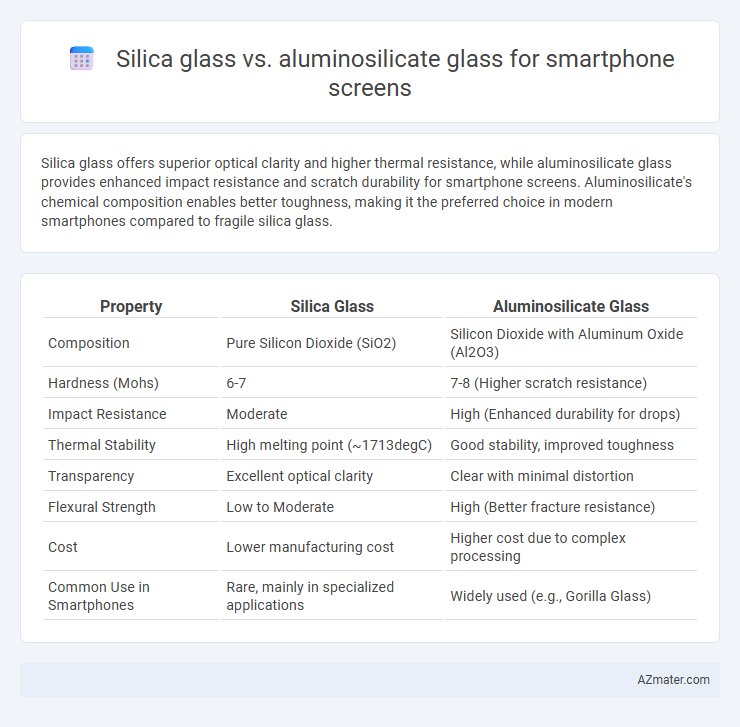Silica glass offers superior optical clarity and higher thermal resistance, while aluminosilicate glass provides enhanced impact resistance and scratch durability for smartphone screens. Aluminosilicate's chemical composition enables better toughness, making it the preferred choice in modern smartphones compared to fragile silica glass.
Table of Comparison
| Property | Silica Glass | Aluminosilicate Glass |
|---|---|---|
| Composition | Pure Silicon Dioxide (SiO2) | Silicon Dioxide with Aluminum Oxide (Al2O3) |
| Hardness (Mohs) | 6-7 | 7-8 (Higher scratch resistance) |
| Impact Resistance | Moderate | High (Enhanced durability for drops) |
| Thermal Stability | High melting point (~1713degC) | Good stability, improved toughness |
| Transparency | Excellent optical clarity | Clear with minimal distortion |
| Flexural Strength | Low to Moderate | High (Better fracture resistance) |
| Cost | Lower manufacturing cost | Higher cost due to complex processing |
| Common Use in Smartphones | Rare, mainly in specialized applications | Widely used (e.g., Gorilla Glass) |
Introduction to Smartphone Glass Materials
Silica glass and aluminosilicate glass are two primary materials used in smartphone screen manufacturing, each offering distinct properties. Silica glass, composed mainly of silicon dioxide, provides excellent optical clarity and heat resistance but is relatively brittle. Aluminosilicate glass incorporates aluminum oxide into the silica matrix, enhancing strength, scratch resistance, and durability, making it the preferred choice for modern smartphone displays.
What is Silica Glass?
Silica glass, also known as fused quartz, is made primarily from silicon dioxide (SiO2) and is renowned for its exceptional thermal stability, optical clarity, and chemical resistance. In smartphone screens, silica glass provides high scratch resistance and durability but tends to be more brittle compared to aluminosilicate glass. Unlike aluminosilicate glass, which includes aluminum oxide enhancing toughness and shatter resistance, silica glass is favored for applications requiring superior heat resistance and transparency.
What is Aluminosilicate Glass?
Aluminosilicate glass is a type of glass composed primarily of silica and alumina, offering superior strength and resistance to scratches and impacts compared to traditional silica glass. This enhanced durability makes aluminosilicate glass ideal for smartphone screens, providing better protection against drops and daily wear. Its chemical composition allows for higher thermal stability and improved toughness, crucial for modern mobile devices that demand both clarity and robustness.
Key Material Properties Comparison
Silica glass offers exceptional hardness, chemical durability, and high thermal resistance, making it ideal for scratch-resistant smartphone screens but tends to be more brittle and prone to shattering on impact. Aluminosilicate glass, reinforced with aluminum oxide, provides superior toughness and impact resistance while maintaining good scratch hardness and thermal stability, enhancing overall durability for everyday smartphone use. The optimized balance of mechanical strength and flexibility in aluminosilicate glass results in improved shatter resistance compared to pure silica glass, making it a preferred choice for modern smartphone display protection.
Scratch Resistance: Silica vs Aluminosilicate
Aluminosilicate glass demonstrates superior scratch resistance compared to silica glass due to its enhanced hardness and chemical durability, making it the preferred choice for premium smartphone screens. The incorporation of aluminum oxide within aluminosilicate glass significantly increases its resistance to abrasion from everyday materials like keys and sand. While silica glass offers basic protection, aluminosilicate glass's higher Mohs hardness rating ensures longer-lasting screen clarity and fewer surface scratches.
Impact Strength and Durability
Aluminosilicate glass offers superior impact strength and durability compared to traditional silica glass, making it the preferred choice for smartphone screens subject to daily wear and accidental drops. Its enhanced resistance to scratches, cracks, and thermal stress results from the incorporation of aluminum oxide, which increases hardness and structural integrity. Smartphones using aluminosilicate glass exhibit longer-lasting screens with better performance under impact and environmental stresses.
Optical Clarity and Display Quality
Silica glass offers exceptional optical clarity due to its high purity and low impurity levels, resulting in minimal light distortion and enhanced display sharpness. Aluminosilicate glass, although slightly less transparent than pure silica, provides superior impact resistance and scratch durability while maintaining excellent light transmission, crucial for vibrant and clear smartphone displays. The balance between optical clarity and mechanical strength in aluminosilicate glass makes it the preferred choice for modern smartphone screens, where both display quality and durability are essential.
Cost and Production Considerations
Silica glass offers excellent optical clarity and high-temperature resilience but entails higher production costs due to lengthy manufacturing processes and energy-intensive melting. Aluminosilicate glass, favored in smartphone screens, provides superior toughness and scratch resistance with a more cost-effective production cycle enabled by rapid forming techniques such as ion-exchange strengthening. Mass production efficiency of aluminosilicate glass reduces per-unit expense, making it economically advantageous over traditional silica glass for consumer electronics applications.
Real-world Performance in Smartphones
Aluminosilicate glass offers superior scratch resistance and durability compared to traditional silica glass, making it more effective against everyday impacts and drops in smartphones. Its enhanced chemical composition improves resistance to breakage and thermal stress, contributing to longer screen lifespan under typical usage conditions. Real-world performance tests show aluminosilicate glass maintaining clarity and structural integrity better than silica glass after prolonged exposure to abrasion and pressure.
Choosing the Right Glass for Mobile Devices
Aluminosilicate glass offers superior scratch resistance and higher impact strength compared to silica glass, making it the preferred choice for smartphone screens exposed to daily wear and accidental drops. Its enhanced chemical durability and thermal stability ensure long-lasting clarity and performance under various environmental conditions. Manufacturers prioritize aluminosilicate glass for mobile devices due to its balance of toughness, optical quality, and resistance to damage, contributing to improved user experience and device longevity.

Infographic: Silica glass vs Aluminosilicate glass for Smartphone screen
 azmater.com
azmater.com